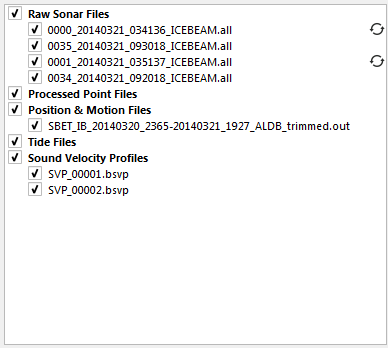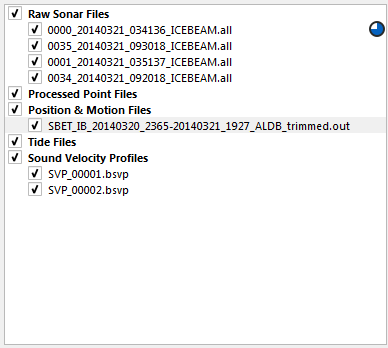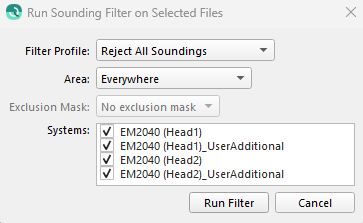Qimera Project Sources Dock
Qimera - Project Sources
The Project Sources tab of the Source Files Panel shown in the Source Files Tab figure above shows all of the files currently loaded into a project. If you have loaded directories of files, the directory hierarchy will be preserved in the Source Files Tree. There are 5 primary root nodes in the tree. Raw Sonar Files, Processed Point Files, Position & Motion Files, Tide Files and Sound Velocity Profiles.
Source File Tree Nodes
Raw Sonar Files
These nodes are raw sonar files you have imported for Sound Velocity Correction, Dynamic Grid generation and Swath and 3D Editing operations. A list of supported formats can be found here.
Processed Point Files
These nodes are processed point files you have imported for Dynamic Grid generation and 3D Editing operations. A list of supported formats can be found here.
Position & Motion Files
These nodes are either ASCII or binary position and motion files that you have imported to be used during Sound Velocity Correction or Re-Navigation processing. A list of supported formats can be found here.
Tides
Tide nodes represent tidal data brought into the project to support final height determination in the sound velocity correction pipeline or as a Re-Navigation operation. Tide nodes are divided into two categories: tide stations and tide strategies.
Tide stations represent a set of tide measurements all measured at the same location, against the same datum, in the same unit and in the same timezone. Each tide station can contain many tide files, which are shown as its children in the tree. A list of supported tide file formats can be found here.
Tide strategies combine and/or transform the tide data from one or more tide stations to allow for advanced tide modelling. A tide strategy can do weighted interpolation of data between stations or establish a zone inside with station data are offset or scaled. Tide strategies are powerful building blocks from which very complex tide scenarios can be modeled.
Sound Velocity Profiles
These nodes represent imported data or data extracted from raw sonar files during import. They are displayed here so that you can more easily delete them if they are not needed. They are used during Sound Velocity Correction. A list of supported file formats can be found here.
Selection and Visibility
When you select a raw sonar file in the tree, the corresponding track line in the 4D Scene will highlight. Conversely, when you select a track line in the 4D Scene, the associated raw sonar node will highlight. Change the visibility of the node in the 4D Scene by changing the state of the checkbox. Checked is visible, unchecked is invisible.
Raw Sonar File Processing State
When raw sonar files are added to Qimera, they need to ultimately get converted into QPD files through Sound Velocity Correction. If a sonar file requires processing, the auto-solve icon will appear at the right side of the window as shown below. If you hover over the icon, Qimera will tell you exactly which type of processing needs to be accomplished. Whenever you modify data or settings that affect the line, Qimera will know this using the Dynamic Workflow engine and mark the line as requiring further processing.

Pressing the Auto Solve icon will cause the line to be processed. During processing, you will see the job in the Activity Monitor as well as an indication next to the line as to the remaining duration of it's processing

Right Click Context Menus
Because many actions are available to multiple file types the actions are annotated by a type number 1-6 associated with the menus listed below.
Raw Sonar File Context Menu
Add Raw Sonar Files
This action will launch the Qimera Add Raw Sonar Files Dialog dialog to add raw sonar files to your project.
Edit Processing Settings
This action will launch the Processing Parameters dialog for the current selection.
Edit Vessel Configuration
This action will launch the Vessel Editor for the current line selection.
Edit Modified Flags
This action will launch the Manual Modified Flags dialog allowing the user to manually clear or set processing flags.
Dry Run
This action will launch the Dry Run dialog allowing the user to test run the configuration setup for the processing of the selected lines.
Attach Scroll Selection to Trackline
This feature is used in combination with the Scroll Line Select Mode to have the selection follow that Trackline.
Export
Export Soundings to ASCII
Launches the Qimera Export Soundings to ASCII Dialog and will export the selected raw sonar files.
Export to LAS/LASZip
Launches the Qimera Export Soundings to LAS/LASzip Dialog that enables export of individual LAS or LASzip files containing points from the selected file.
Export to GSF
Launches the Qimera Export to GSF Dialog This option will export the selected raw sonar files to GSF files.
Export to SD Points
This option will export the selected sonar files to SD Point objects. Qimera will also pay attention to a spatial selection. You have the option to specify which systems to export. Qimera will add a User Additional system for each multibeam head that will be the container for any water column picks that you add. You also have the option to merge all the lines into a single SD and an option to automatically load the SD object to the scene. Qimera exports the following attributes to the SD Point object: X, Y, Z, Time, System, Ping, Beam, Intensity, Horizontal TPU, and Vertical TPU.
Export to SD Cluster
This option will export the selected sonar files to SD Cluster objects. Qimera will also pay attention to a spatial selection. You will see the same option dialog as you do when exporting SD Points. You have the option to specify which systems to export. You also have the option to merge all the lines into a single SD and an option to automatically load the SD object to the scene.
If you have done water column picking of geophysical processes such as seeps, use this option to export only your water column picks (SystemName_UserAdditional) into a single SD Cluster object. Then load this object into Fledermaus to do cluster analysis. Remember you can do water column picking for all of your lines, then export all line picks into a single object using the Merge to single file option.
Export to FAU
This option will export the selected raw sonar files to FAU files. The exported data will appear in the project ~/Export sub-directory.
Export to QTR
This option will export the currently selected raw sonar files to QTR files. The exported data will appear in the project ~/Export sub-directory.
Export Trackline to ASCII
This option will export ASCII files containing date/time, x, y, and z for the currently selected raw sonar files. The exported data will appear in the project ~/Export sub-directory. A separate file will be exported for the center of gravity and each sonar head.
Export to NOAA CSV Format
This option exports a CSV file containing metadata for each of the selected raw sonar files. The metadata columns in the CSV file are:
MB Line Filename, Speed, HDG, Longitude Min, Longitude Max, Latitude Min, Latitude Max, Linear Distance, Min Time, Max Time, SVP File Applied, Julian Day, Date (UTC)
Processed Point File Context Menu
Add Point Files
This action will launch the Add Point Files dialog to add processed point files to your project.
Load Associated DB File
Shown only for QPD files, this action will attempt to find and load the corresponding DB file, replacing the QPD file in the source tree in the process. This essentially upgrades the line from point cleaning only to being able to be fully process-able.
Generate Metadata
This action re-generates the metadata for the processed point file.
Edit File Configuration
This action will launch the File Configuration dialog for the current selection.
Edit TPU Setup
This action will launch the TPU Calculation dialog for the current selection.
Unload Changes
This action will launch the Qimera Unload Processed Point File Dialog for the current selection.
Export
Export Soundings to ASCII
Launches the Qimera Export Soundings to ASCII Dialog and will export the selected raw sonar files.
Export to LAS/LASZip
Launches the Qimera Export Soundings to LAS/LASzip Dialog that enables export of individual LAS or LASzip files containing points from the selected file.
Export to FAU
This option will export the selected raw sonar files to FAU files. The exported data will appear in the project ~/Export sub-directory.
Export to QTR
This option will export the currently selected raw sonar files to QTR files. The exported data will appear in the project ~/Export sub-directory.
Position & Motion File Context Menu
Add Binary Navigation Files
This action will launch the Navigation Import dialog.
Tide Station and Tide File Context Menu
Add Tide Files
This action will launch the Add Tide File dialog to start the tide file import process, which is also how tide stations are created.
Edit Tide Station
This action launches the Tide Station dialog to edit the properties of an existing tide station. Note that not all properties are editable after creation.
Tide Strategy Context Menu
Create Tide Strategy
This action will launch the Tide Strategy dialog to create a new tide strategy.
Edit Tide Strategy
This action launches the Tide Strategy dialog to edit the properties of an existing tide strategy. Note that not all properties are able to be edited after the initial creation.
Sound Velocity Context Menu
Import SVP Files
Enables selection of an SVP file to import into the project. If applicable, further dialogs will launch in support of the import operation.
SVP Editor
This action will launch the Qimera SVP Editor for the current selection.
Select Associated Source Files
This action will clear the current source item selection and select all the source files that use the selected SVP.
Export
Export to ASCII SVP
Export to Caris SVP
Export to Hypack SVP, Version 2
Export to Hypack SVP, Version 3
Common Context Menu Actions
Append Lines to a Dynamic Grid
This action will launch the Append Lines dialog to append the current selection to a Dynamic Grid.
Remove Lines from a Dynamic Grid
This action will launch the Remove Lines dialog to remove the current selection from a Dynamic Grid.
Select in Area
This action will deselect any lines that are not overlapping the selected area in the 4D view.
Run Sounding Filter on Files
This action will launch the Run Sounding Filter on Files dialog shown below. Use the Filter Profile drop down to selected which filter you want to run. Use the Area drop down to run the filter Everywhere or Inside Current Selection. You can also use the Exclusion Mask option to prevent the filter from running in a specific area of the survey. You can uncheck systems that you want the filter to ignore. For more information on filtering, see the section on the Filter Operation Toolbar.

Apply Edits from...
This action will apply cleaning edits from .fau, QPD, or qpdedits files to their corresponding files in Qimera's project. To use this tool, select the files that correspond to the selected source items. Selected .fau files must include all rejected soundings. If there are multiple systems in the Qimera source files, the files must be split by head, and the file names given on export from Qimera must not be changed in order for edit flags to be properly applied.
Export QPD Edits
Export a .qpdedits file which will be located in the project Export folder. The .qpdedits file is used for transferring point edits from one project to another. It can also be used to create a snapshot of the current cleaning status of the selected files.
Add Group
This action will add a custom named group to the tree hierarchy.
Create Group From Selection
This action will launch the Add Group dialog to add a custom named group from the currently selected files to the tree hierarchy.
Rename Group
This action will launch the Rename Group dialog to change the name of the selected group.
Organize Sub-Menu
Appears when clicking on groups and provides options for (re)organizing source files within the group. Alphabetize reorders files and groups to appear in alphabetical order, while preserving any group hierarchy. The Regroup by... action creates a hierarchy of groups and sorts the files into them. Different file types support different Regroup by... operations. These options are: Regroup by Vessel, Regroup by Vessel and Day, Regroup by Day and Vessel, Regroup by Day, Regroup by File Path.
Remove All Grouping flattens the hierarchy by removing all groups while preserving file ordering.
Note that the Organize menu operations are not automatically reapplied if files are later added to or removed from the project. They are one-off operations to organize the source files according to a particular scheme, but the user still has the option to customize via the creation of their own groups or drag-and-drop reordering.
Order by Name
Reorders the contents of the selected group to put the sources in alphabetical order. This preserves all existing groups, but reorders them and their contents.
Order by Start Time
Reorder the contents of the selected group to put the source in order by their start time. Note that not all source types have an associated start time. This preserves all existing groups, but reorders them and their contents.
Regroup by Vessel
Remove all existing groups below the selected group and create a new hierarchy with each vessel being given its own group. Note that not all source types have an associated vessel.
Regroup by Vessel and Day
Remove all existing groups below the selected group and create a new hierarchy with each vessel being given its own group containing subgroups for each day.
Regroup by Day and Vessel
Remove all existing groups below the selected group and create a new hierarchy with each day being given its own group containing subgroups for each vessel.
Regroup by Day and Vessel
Remove all existing groups below the selected group and create a new hierarchy with each day being given its own group containing subgroups for each vessel.
Regroup by Day
Remove all existing groups below the selected group and create a new hierarchy with each day being given its own group. For this purpose, the day is the date on which acquisition of that source began. Not that not all source types have an associated start time.
Regroup by File Path
Remove all existing groups below the selected group and create a new hierarchy mirroring the file folder hierarchy of the sources on disk.
Remove All Grouping
Remove all existing groups below the selected group, flattening the group hierarchy.
Select Sub-Menu
Appears when right clicking on groups or files and provides options for selecting source files within the group. Files and Groups can have different options. These options are: Select All Files in the Same Vessel, Select All Files with the Same Start Date, Select All Files in the Same Folder, Select All Missing Files, Select All Files with Errors, Select All Files that are Ready for Processing, Select All Files that are Fully Processed, Select All Empty Raw Sonar Files.
Select All Files In the Same Vessel
Select all files that are from the same vessel as the current selection. This does not include different configurations in that vessel.
Select All Files With the Same Start Date
Select all files that begin on the same day as the current selection.
Select All Files in the Same Folder
Select all files that are in the same folder as the current selection.
Select All Missing Files
Select all files that were not found during project (re)loading.
Select All Files With Errors
Select all files that returned errors during processing.
Select All Files that are Ready for Processing
Select all files that are ready to process.
Select All Files that are Fully Processed
Select all files that have completed their processing.
Select All Empty Raw Sonar Files
Select all Raw Sonar Files that do not contain soundings.
Remove
This action will remove the current selection from the project. Using the shortcut key 'Del' will also remove the current selection from the project.
Zoom to Bounds
This action will zoom the scene to the bounds of the current selection.
File Paths
Open Containing Folder
This action opens a file browser showing the folder containing the selected file.
Find New File Location...
This action allows you to point Qimera to the new location of a file that has moved since it was added to the project. Qimera will use this new location to try to find any other missing files.
Find Matching QPD...
For raw sonar files, this action will allow you to find the matching QPD's for a loaded DB file that failed to match during metadata extraction.
Find Matching WCD...
For raw sonar files, this action will allow you to find the matching WCD files (Kongsberg water column data) for a loaded Kongsberg raw sonar file that failed to match during metadata extraction.
Datagram Viewer
This action will launch the Datagram Viewer dialog, showing the key metadata of the selected file.
Return to: Qimera Interface
Return to: Dockable Windows
